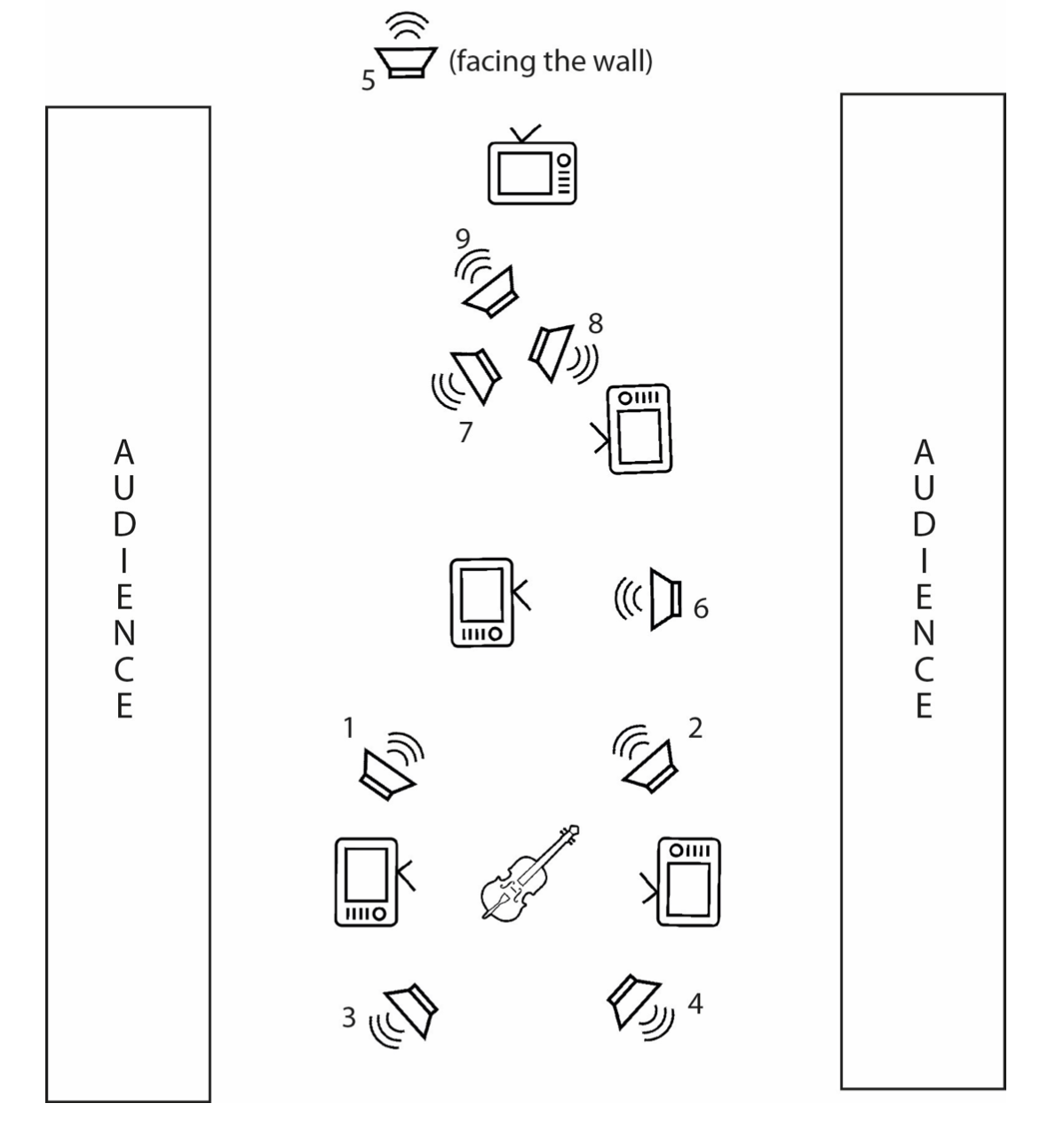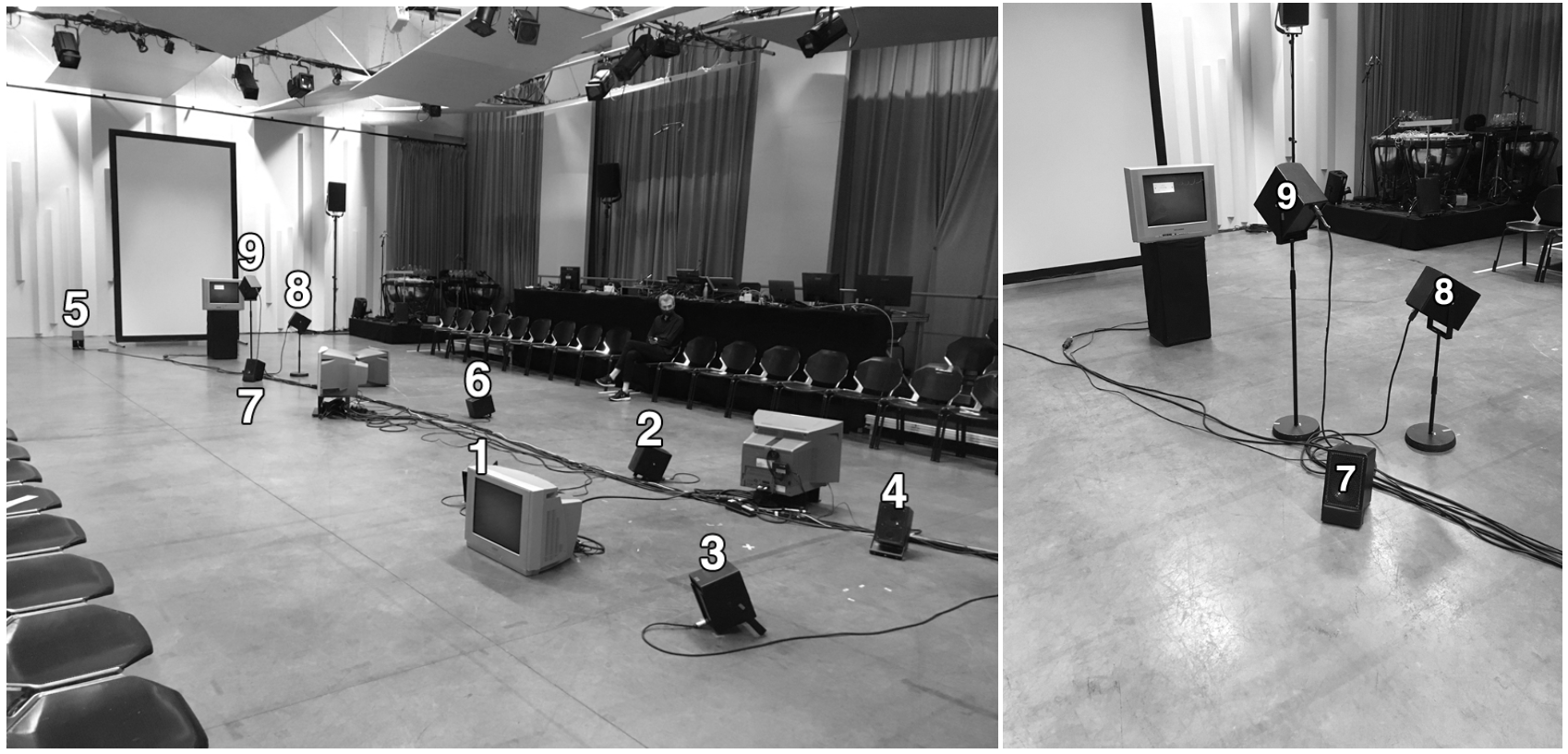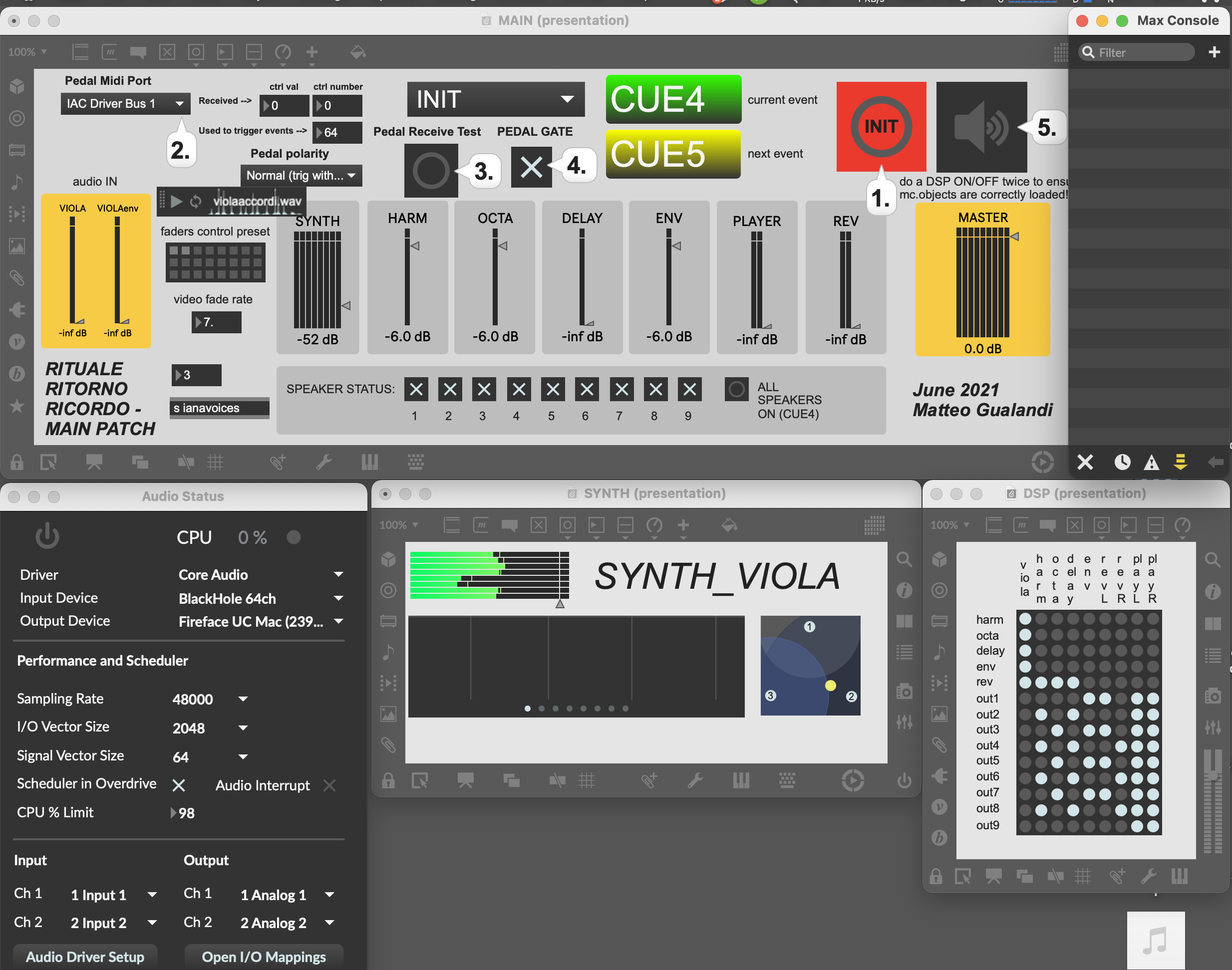Table of contents
- First performance
Documentation date: 21 mars 2023
Version state
Valid
Validation date: 23 mars 2023
Version documentalist
- lemouton (Serge.Lemouton@ircam.fr)
Version realisation
- Grégoire Lorieux (Computer Music Designer)
Version length
11 mnNo other version available
Detailed staff
- alto
Channel details
- Number of input channel : 1
- Number of output channel : 9
Electronic equipment list
Computer Music Equipment
-
2 MacBook Pro - Apple Laptops
(Apple)
one for audio, and the other for the video -
1 Footswitch / Sustain Pedal - Footswitch / Sustain Pedal
Audio Equipment
-
1 Microphone - Microphone
for the viola -
9 Loudspeaker - Loudspeakers
-
2 subwoofer - Subwoofers
Work related information
Premiere
- 12 juin 2021, France, Paris, CENTQUATRE, festival ManiFeste 2021, concert du Cursus
Realisation
- Grégoire Lorieux
Work length
- 8 mn 30 s
Event
- Concert Cursus - sam 12 Jui 2021 - Atelier 9 CENT QUATRE - -
Useful links on Brahms
- Rituale Ritorno Ricordo pour alto, vidéo et électronique (2021), 8mn
- Matteo Gualandi
| File | Author(s) | Comment | |
|---|---|---|---|
| Download [589,4 Mio] | Patch patches and sounds | Matteo Gualandi |
Instructions
Rituale Ritorno Ricordo is a piece for Viola, electronics (played through a Max 8 patch) and a video (played through a jitter patch), displayed over a certain numbers of CRT televisions.
The piece was realized during the Cursus 2020-21 at Ircam Centre Pompidou in Paris, with the technical assistance of Grégoire Lorieux and Arnaud Delacelle.
Required materials:
• 1 Macbook pro (equipped with Max 8) to operate the audio patch;
• 1 Macbook pro (equipped with Max 8) to operate the video patch, connected to the other
computer through an OSC connection. If the main computer is powerful enough, both video
and audio patches could be executed on the same machine;
• 1 DPA microphone for the viola;
• 9 small loudspeakers (Amadeus PMX5 or similar);
• 2 subwoofers;
• 5 CRT televisions (same video stream displayed on all of them);
• 1 MIDI pedal to allow the musician to trigger the events.
Setup:
The amount of loudspeakers is flexible, depending on the size of the space: from a minimum of 4 (+ subs) to a maximum of 9 (+ subs).
The same is valid for the amount of TVs: every member of the audience should be able to watch comfortably at least one television.
The first performance took place in a bi-frontal space. Here is a schema of the stage:
The piece can be played as well in a frontal or flexible arrangement.
When placing the speakers for a different space, keep in mind that 1-2-3-4 should be always kept in the same disposition around the viola, 7-8-9 should be considered as a group, and 5 should be quite far and directly pointing at a wall.
All speakers should be lightly pointing upwards. 1-7 should be directly on the floor or slightly elevated, 8 and 9 could be placed at progressively higher length from the floor (see the pictures for reference).
If the 4 speakers version is played, just keep the first four around the viola.
Televisions can be freely placed in the hall. Ideally, every member of the audience should be able to see at least 2 or 3 of them. If CRT TVs are unavailable, small lo-fi screen might be used instead.
While the version with video is to be preferred, the piece can also be played in its purely acoustic form.
Each speaker should be separately illuminated (this could happen with LED lights or projections from above). After Cue 11, loudspeakers are turned off one by one during the piece in the following order: 6, 7, 8, 9, 1, 4, 3, 5, 2. Each time a speaker turns off, its light fade out slowly (follow the cue list for reference).
Patch documentation
To play the piece, open at the same time the three patches: MAIN, DSP and SYNTH.
Follow the initialization procedure as indicated into the main.
To ensure multichannel (mc) objects are correctly loaded, please turn ON and OFF once the general DSP before starting the patch.
NB: For technical reasons, SPAT might produce some error messages right before initialization. This won’t affect the performance.
Notes for performance:
Cues encircled by squares should be triggered by the musician; cues surrounded by circles should be triggered from the computer.
Live mixing of audio levels during the performance is highly recommended to ensure balance and flexibility. The faders in the patch can be easily controlled with a MIDI controller,
The first performance of the piece took place on 12/06/2021 in the Atelier 11 of CENTQUATRE theater, Paris. It was performed by Jack Stulz, with the technical assistance of Grégoire Lorieux and Arnaud Delacelle.
Program note
Rituale (rituel) : procédé cérémonial et peut-être douloureux pour pouvoir remonter jusqu’aux racines. Ritorno (retour) : apparition tendre, voire abyssale d’images familiales, intimes, en partie disparues. Ricordo (souvenir) : couleur émotive profondément liée à chacune de ces images et, en même temps, indépendante et libre. Une à une, les images et les enceintes nous laissent telles que des bougies. Reste alors des fragments du langage qui nous appartient, mais sous une nouvelle lumière. Martin Heidegger écrit, à propos de son travail : « … cela exige une attention renouvelée au langage ; non pas une invention de termes nouveaux, mais une retraite vers le contenu primordial de notre propre compréhension du langage, incessamment à l’agonie. »Matteo Gualandi, note de programme du concert ManiFeste du 12 juin 2021 au CENTQUATRE-PARIS.
Version documentation creation date: 21 mars 2023 11:49, update date: 23 mars 2023 15:27